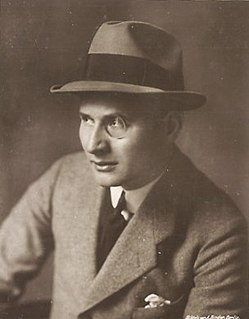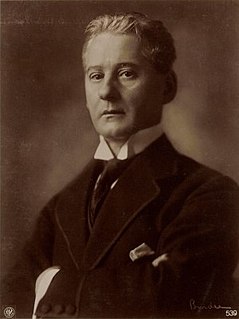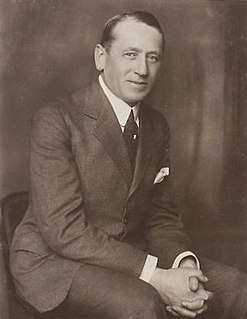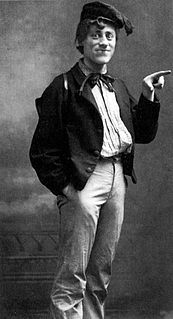This article needs additional citations for verification .(April 2016) |
Siegfried Berisch (? - 4 October 1933 in Vienna), was a German-Jewish [1] actor.
This article needs additional citations for verification .(April 2016) |
Siegfried Berisch (? - 4 October 1933 in Vienna), was a German-Jewish [1] actor.

Franz F. Planer, A.S.C. was a Czech-born cinematographer born in Karlsbad, Austria-Hungary.

Sig Arno was a German-Jewish film actor who appeared in such films as Pardon My Sarong and The Mummy's Hand. He may be best remembered from The Palm Beach Story (1942) as Toto, the nonsense-talking, mustachioed man who hopelessly pursues Mary Astor's Princess Centimillia.

Walter Rilla was a German film actor of Jewish descent. He appeared in more than 130 films between 1922 and 1977. He was born in Neunkirchen, Germany and died in Rosenheim, Germany.

Walter Janssen was a German film actor and director. He appeared in more than 160 films between 1917 and 1970.

Julius Falkenstein was a German stage and film actor of the silent era. He appeared in 184 films between 1914 and 1933. Falkenstein was Jewish, but secured a special permit to continue making films following the Nazi rise to power in 1933. He died of natural causes the same year, having made only one further film.

Paul Richter was an Austrian film actor. He owed his great popularity in German films of the silent era largely to the directors Joe May and Fritz Lang.

Lissy Arna was a German film actress. She appeared in 63 films between 1918 and 1962. She starred in the 1931 film The Squeaker, which was directed by Martin Frič and Karel Lamač. She entered U.S. films in 1930 under the direction of William Dieterle, appearing in German-language versions of American films.

Otto Wallburg was a German actor and Kabarett performer. He was a prolific film actor during the late silent and early sound era.

Evelyn Holt was a German actress.

Paul Biensfeldt was a German-Jewish stage and film actor.
Günther Krampf was an Austrian cinematographer who later settled and worked in Britain. Krampf has been described as a "phantom of film history" because of his largely forgotten role working on a number of important films during the silent and early sound era. Only two of Krampf's films The Student of Prague (1926) and The Ghoul (1933) were expressionist, as he generally used a naturalistic style.

Eugen Burg was a German actor. His daughter was Hansi Burg. Burg was a close friend of the actor Hans Albers.

Paul Morgan was a Jewish Austrian actor and Kabarett performer. He died in Buchenwald concentration camp in 1938.
Adolf Lantz (1882-1949) was an Austrian screenwriter. Lantz went into exile following the Nazi takeover of power in Germany, and died in London.

Maria Forescu was an Austro-Hungarian-born Romanian opera singer and film actress. During the silent and talkies era of the German cinema, she appeared in several movies as a supporting actress. When Adolf Hitler came to power, Forescu, like other Jews of that period, was barred from her profession. Living undercover during the later years of World War II, she survived the Holocaust and died in 1947 in East Berlin.
Jacek Rotmil (1888–1944) was a Russian-born art director and production designer who worked on 100 films during his career Following the First World War, Rotmil entered the booming German film industry and worked prolifically until 1933. Following the Nazi rise to power, Rotmil went into exile in Poland where he was employed frequently on Polish and Yiddish productions. He had first become involved in the Polish film industry in 1930 when working on the sound version of the Polish film Exile to Siberia in Berlin.
Franz Schroedter was a German art director.
Heinrich Gotho was an Austrian film actor. Born in Dolina, he started his acting career at some provincial theatres until he found an engagement at the Neues Volkstheater in Berlin. The character actor appeared in over 50 films between 1922 and 1933, mostly in smaller roles. He notably appeared in numerous films by director Fritz Lang, among them Dr. Mabuse the Gambler (1922), Metropolis (1927) and M (1931). Gotho was forced to retire from film acting in 1933; as a Jew he could no longer work in Nazi Germany. He died in 1938 in the Jewish Hospital of Berlin-Wedding.
The Queen of the Baths is a 1926 German silent comedy film directed by Victor Janson and starring Mary Nolan, Walter Rilla and Livio Pavanelli.
Maxim Galitzenstein was an Austrian film producer active in the German film industry during the silent era. Of Jewish background, Galitzenstein was associated with the film pioneer Oskar Messter before the First World War.